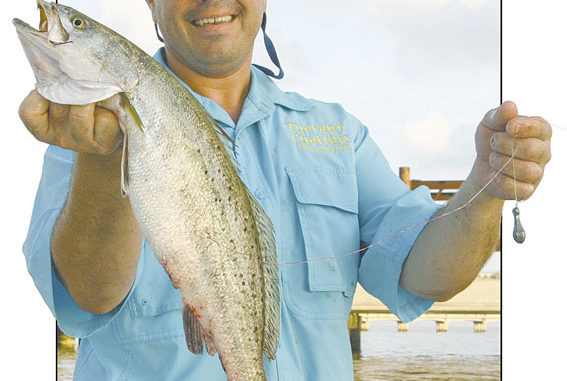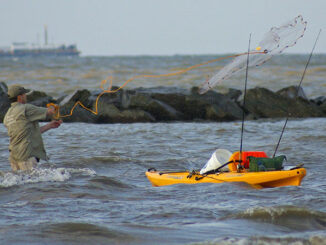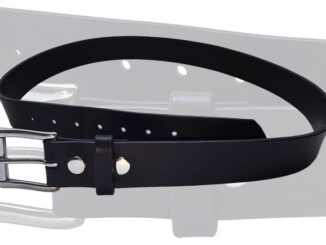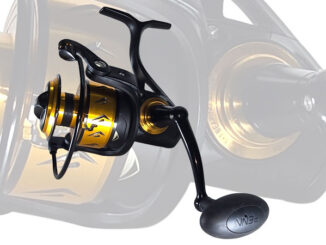
I’m no Donald Trump, but a 30-percent return on an investment sounds like a pretty good deal to me. Simple math shows that investing $100 with a 30-percent rate of return would result in $130. One-thousand dollars would turn into $1,300 and $100,000 would become $130,000.
That’s why Therapy Charters owner John Falterman’s claim that a change in fishing techniques that resulted in a 30 precent greater catch in 2010 than 2009 seems a little far-fetched. You might think this tale is nothing more than a fish story, but Falterman has the records in his logbook to back it up.
For a charter captain, a 30-percent rate of return means 25-fish limits for five anglers rather than four. I don’t book very many charter captains, but those kinds of numbers would definitely have me calling Falterman back time and time again just like an investor would keep pumping money into a mutual fund that continually provided a 30-percent profit.
Falterman says his drop-shot fishing technique has totally replaced his Carolina rig. His drop-shot rig has totally replaced his sliding-cork rig. And his drop-shot rig is just about to totally replace his jigging rig.
“Last year, we averaged somewhere around 60 fish a trip between May and November when we could get live shrimp,” Falterman began. “And we had quite a few trips with up to 150 a trip for six anglers.
“The rig I fish today is born out of knowledge of two people who have been around for a long time, Mike Gallo and Dudley Vandenborre. I put bits and pieces of what works for them into something that I feel is totally right for me.”
First, Falterman credited Gallo with being the inspiration for trying a drop-shot rig. However, Falterman wasn’t sold on the octopus hook that Gallo used on his drop-shot rig. That’s when he turned to Vandenborre, who had been using a treble hook on his Carolina rig. The end result was Gallo’s drop-shot rig with Vandenborre’s treble hook.
It was just about this time last year when Falterman started posting some unbelievable images and reports on LouisianaSportsman.com and on his Facebook account on an almost daily basis.
Besides not being The Donald, I’m not an investigative reporter either, but I just had to get to the bottom of what looked at the surface to be some epic shenanigans more frequently found in Louisiana political circles than under the Twin Span.
I cornered Falterman, and persuaded him to take my son and me fishing so we could see firsthand exactly how he was putting more than 100 trout a day in his charter boat. Our first stop was below the towering pilings under the newly constructed I-10.
Our rods were ready to go with some Carolina rigs I had tied on the night before. However, Falterman instructed me to cut them off as he handed me a couple pieces of monofilament that looked like double rigs with weights at one end and treble hooks at the other.
“Drop shot,” Falterman said. “Tie your main line to that loop in the middle, and you’re ready to go.
“I don’t think a lot of people are using this rig now even though some people are starting to get wind of it.
“A lot of people don’t want to change the way they learned to fish when they were young, but if I hear about something working better than what I’m doing, you can bet I’m going to try it. If it produces, I’ll stick with it. If it doesn’t, then I’ll stick with my old ways.”
Before a typical guide trip, Falterman rigs eight rods with drop-shot rigs and pre-ties 30 more for spares. He makes his rigs by tying a 1-ounce sinker on one side of a 30-inch piece of 30-pound-test monofilament line and a No. 6 treble hook to the other.
Then he folds the hook end over before tying an overhand knot at the fold. Ideally, he tries to get 12 to 15 inches between the knot and the weight and 8 or 9 inches between the knot and the treble hook. All he has to do is tie his 30-pound Tuf-Line braid directly to the loop at the fold, and he’s ready to fish.
“That’s the beauty of the drop shot,” Falterman said. “It keeps your bait off the bottom where it can’t hide. Take a cocahoe minnow for example. If you’re fishing one of those on a Carolina rig, that minnow is going to bury itself in the mud to get away from being ambushed. When he’s on the drop-shot rig, he can’t get down.”
Falterman also feels another distinct advantage that a drop shot has over a Carolina rig is that it helps anglers feel more bites. Rather than feeling a weight between your rod and your bait as you would with a Carolina rig, a drop-shot rig puts anglers in direct contact with their baits once they snug their lines taut against the weight on the bottom.
“All you feel is the shrimp kicking, and he can move around a lot on this rig,” Falterman said. “When a fish comes up and grabs and pulls down, you physically feel that on the drop shot.
“If trout are slow to bite and they’re just mouthing your bait, you’ll never know they’re on there on a Carolina rig until you pull some pressure back. With a drop shot, once they grab, it you’re setting the hook.”
We began making casts about 15 or 20 feet past the Twin Span pilings into the current. Falterman told us to leave our bails open so our rigs could fall straight down to the bottom. According to his explanation, our live shrimp were washing back to us under a V shape formed between us and our weights.
“You want your bait as natural looking as possible,” he said. “You don’t want it going against the current.
“Bait normally goes with the flow, not against it. If a fish is sitting there by that piling, he’s looking into the current, and you don’t want your bait coming up from his tail to his head.”
It didn’t take long for my son to become a fan of Falterman’s drop-shot rig. He and Falterman’s son Jacob quickly got into a youthful competition to see who was king of the hill at the best corner of the deck so they could throw to the hotspot.
While they were doing that and picking up small trout, Falterman was busily working the pilings. The big numbers he had been putting up just days before were slow to appear, so we bounced around a little bit until he eventually found a pile of fish.
“If I don’t feel anything about five seconds after it hits bottom, I just kind of drag it, just slowly creeping it along on the bottom,” Falterman explained while unhooking a 3-pound trout. “I’ll stop it if I feel it get into a spot where I think a fish may be.
“Sometimes they want to hit it on the run with a steady retrieve, and sometimes they nail it on the way down or up. When I feel that thump, I let the line get taut again and wait for it because usually the first time they hit it and stun the shrimp. Then they’ll come back around and grab it head on to eat it.”
Just to prove that his drop shot would work anywhere, we bounced around all three bridges that span the eastern part of Lake Pontchartrain. Falterman showed that it worked well on the trestle, the Highway 11 bridge and the Twin Span. He even proved that it worked on the rigs out in Lake Borgne.
Although we didn’t make it to any of these places, he added that his drop shot would work well anywhere there was structure like the CSX Train Bridge, the Causeway and even deep canals where trout stack up during the winter.
As we were wrapping up our day, Falterman related a story to me about a day he was filming an episode of Bait to the Plate hosted by Dave DuBos on channel 54 WUPL-TV in New Orleans. DuBos spotted some birds working close to the train trestle, and wanted to hit the fish he just knew were under them.
“I told him I was going to show him the difference between a sliding cork and the drop shot,” Falterman recalled. “I knew there were some big trout down below the smaller fish at the top that just were not going to fight with the school fish. He thought I was joking, so we threw a sliding cork, which went down each cast just as soon as it hit the water — all 12- to 14-inch trout.
“I asked him if he wanted to keep catching those or if he wanted to do this. I took out my drop-shot rig with the 1-ounce weight. It went through the school fish so fast that they couldn’t eat it. We started pulling 2- and 3-pound trout off the bottom. That’s the difference between the two.”
Turning 12-inch trout into 3-pound trout is quite an accomplishment. The same could be said for turning 100 trout into 130. That’s not to say that you’re going to catch 130 every time you hit Lake Pontchartrain this summer. In fact, for most folks, turning 10 trout into 13 may be more like it.
However, that’s still a 30-percent rate of return and one more meal on your plate. You don’t have to be Donald Trump to figure out that investing a little time in learning how to fish a drop shot is going to turn into a sweet deal for you.
Contact Capt. John Falterman at 985-649-3474.


